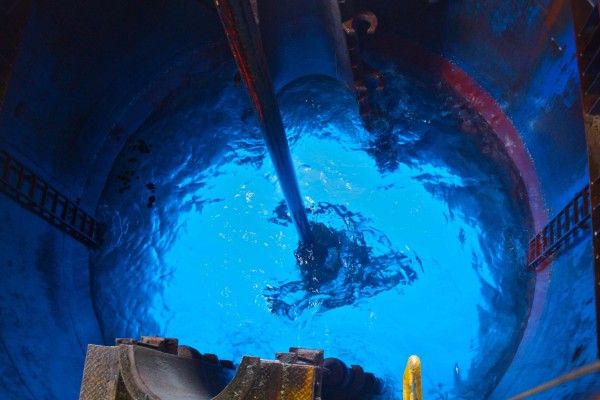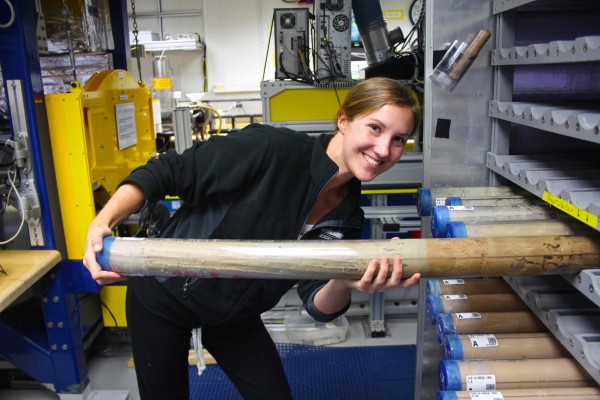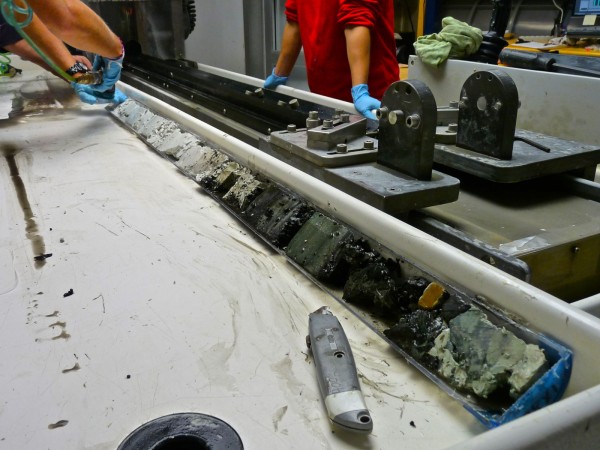There are scientists floating in the middle of the North Atlantic who are holding the dinosaur extinction in their hands. Really. Here it is:

This may look like an alien landscape, but it’s actually a section of deep sea mud from the drilling ship Joides Resolution. When the lighter-toned sediment on the left was deposited, there were dinosaurs and happy marine plankton – the light color is from calcium carbonate shells. The dark grey-black is stuff thrown up by the meteor. Then, in the dark red, there were no dinosaurs, and much less marine plankton with shells. (See the scientists explain it in video here). That’s the idea behind bringing up cores of mud from the deep sea – there’s history in that there mud.
Since one of the co-chief scientists is Scripps professor Dick Norris (when I took his classes, I was really sad that I had not become a geologist!), the education officer Caitlin Scully offered Deep Sea News a behind-the-scenes look at the JR‘s current expedition. While they were pretty excited about finding the dinosaur extinction, they’re primarily interested what came right afterwards. Caitlin writes:
Finding K-T boundary core was one of the most exciting moment’s we’ve had so far! It was perfect. We could see a layer of blackish-green gritty material that the asteroid impact ejected into the atmosphere, which then rained down into the ocean. There was an abrupt change from light grayish sediment, rich in the white calcium carbonate shells of fossil plankton, to brown sediment devoid of calcium carbonate plankton fossils. Many members of our science party posed for pictures with the K-T, our very own celebrity sediment core. Even though the K-T core was amazing, our primary objective is to learn about the climate events that occurred after 65 million years ago.The major goal is to learn more about the Paleocene-Eocene Thermal Maximum, or PETM. Caitlin writes:
Our first drilling location was located in about 5 km of water and we brought sediment onboard that recorded nearly 80 million years of Earth’s past. In one hole we had a record of everything from the K-T Boundary, the Paleocene-Eocene Thermal Maximum, the ELMO, the E-O boundary and records of many smaller climate events. It was if we opened an earth history textbook and made a checklist of important climate events to find – they were all preserved in 300 meters of North Atlantic Sediment. One member of the science party described our cores as a “Box Set of the Greatest Hits of Earth’s Climate Past.”
Expedition 342 is drilling into the past to learn about the future. Our expedition focuses on a time called the Paleogene, which lasted from about 65 to 21 million years ago. During the early Paleogene, Earth’s temperatures were considerably warmer than today and supported swampy forests rather than ice sheets at the poles. The sediment cores we recover will create a detailed reconstruction of ocean chemistry, circulation, and history of this time period. The Paleogene greenhouse world represents a climatic state that the Earth is rapidly re-approaching due to the use of fossil fuels and the subsequent release of atmospheric greenhouse gases. Expedition 342 sets out to answer key questions about the Paleogene such as: How did the climate and ecosystems of the Paleogene world work? What should we expect in the next century? Although the early Paleogene is not a perfect analogue for the future, uncovering the story of past climate change will help us understand what the future holds for our rapidly warming planet.This climate shift can actually be seen in the cores as well. Again, the color change is caused by a mass extinction event, this time of marine plankton called foraminifera.
The JR has also found evidence of huge ocean-wide anoxic events and ancient coral reefs! From their blog:
Imagine the greenhouse world of the Cretaceous – huge volcanoes were spewing carbon dioxide into the oceans and atmosphere, it was hot, there were lots of plants, and, in general, the warm wet climate increased the rate of rock weathering on the planet. In the oceans, phytoplankton flourished. The increased amount of weathering washed huge amounts of critical nutrients like phosphate and nitrate into the oceans. Phytoplankton, small marine plants, depends on nutrients and carbon dioxide to grow, and now they had plenty of both. The result: a phytoplankton boom!Again, you can see where the healthy ocean filled with tiny plankton shells gives way to a thick layer of black goo. That thick black sediment is filled with unused nutrients, which means that no critters were around to use them.
As the exploding phytoplankton population used up the available nutrients they died. The dead phytoplankton rain down into the deep-sea and act as a macabre fertilizer for microbes. These microbes use up huge amounts of oxygen as they feast and decompose the dead phytoplankton. The combination of decay and increased bacterial respiration was so extreme that it caused a global anoxic event. The Cretaceous OAE, also called the Cenomanian-Turonian boundary event or OAE 2, created an ocean starved of oxygen for nearly half a million years. A huge extinction event followed, killing off over 25% of marine invertebrates and charismatic marine reptiles such as ichthyosaurs and plesiosaurs.
Actually getting these cores on deck is quite an operation. There are 126 people on board the Joides Resolution, all working 12-hour shifts, with science operations proceeding 24 hours a day. Caitlin writes:
You can imagine piston coring to be like pushing a drinking straw into a soft layer cake – when you pull up the straw, it’s full of cake! But the JOIDES Resolution is searching for sediment in deep water with strong currents. For us, piston coring is more like standing on top of a 10-story building, with hundreds of straws taped together to make a long tube, trying to impale a mini cupcake, in high winds. I’m constantly amazed that we can bring up as much sediment as we do. Just last week Expedition 342 broke a JOIDES Resolution record – while piston coring we brought up fifteen sediment cores in twelve hours! That is a new 9-meter record of millions of years of Earth’s climate history being brought on deck every 45 minutes!
…No matter where we are, at each site we usually drill 3 holes. So with our current plan, we will drill 9 sites x 3 holes at each x 25 cores per hole = 675 9-meter sediment cores brought on deck! That’s a lot of climate history! Each core is cut into more manageable 1.5-meter sections, and then is run through a series of tests in our core lab. You can learn about that process in Expedition 342’s video Time Machine.

Looking
down into the moon pool in the center of the ship where the drill goes
down. In this picture there’s a big camera sled affixed to the end.
Communicating science from the JOIDES Resolution is an educator’s dream job – The ship is inherently cool (471 feet long with a hole in the middle called the “moon pool”), it travels to exotic locations around the world, it is gone for long periods of time, and is responsible for changing the way we think about science (cores from the JOIDES Resolution proved the theory plate tectonics). For Expedition 342, I’m lucky enough to be able to incorporate the story of the Titanic into our science message, extending our reach to new audiences. The Education Officer is in charge of keeping our followers up to date on the blog, twitter, tumblr, and Facebook Page. Also, I conduct live Ship-to-Shore broadcasts with schools, museums, aquariums, camps, and conferences. During the broadcast I use my iPad and Skype to take groups on tours around the ship and through the labs. Then the public gets the opportunity to ask members of our science party questions about climate science, life at sea, or anything they want. It makes teaching paleoclimate, a challenging topic, relatable, interactive, and best of all, exciting. The Consortium for Ocean Leadership, located in Washington D.C., is responsible for hiring and training a new education officer for every expedition.
I became involved through my work at Scripps Institution of Oceanography. I used IODP data to date the charismatic Claron Formation – the rocks that create Bryce Canyon National Park. For part of my masters, I created educational materials describing geology and isotope dating for the National Park Service. As the Education Officer, I have to understand both the science happening onboard the JOIDES Resolution and the best way to communicate it to the general public. I’m aided by my experience as an educator, naturalist, and blogger for the Birch Aquarium at Scripps, where I taught people of all ages a range of marine science topics.



No comments:
Post a Comment